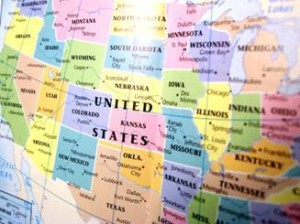 Are you researching your family history? Historical maps can be an exceptional tool when you are beginning a genealogy research project. Because maps can give you important details about business and property ownership, they can be a significant source of information. This information can tell you what and whom you need to research to learn more. The goal of this site is to help you discover important information to get started.
Are you researching your family history? Historical maps can be an exceptional tool when you are beginning a genealogy research project. Because maps can give you important details about business and property ownership, they can be a significant source of information. This information can tell you what and whom you need to research to learn more. The goal of this site is to help you discover important information to get started.
Each State page contains rotating animated maps showing all of the county boundary changes & all of the county boundaries for each census year for each year. Past and present maps of US are overlaid so that you can see the changes in county boundaries, downloadable County D.O.T. Maps, and state atlas maps.
Alabama, Arizona, Arkansas, California, Colorado, Connecticut, Delaware, Florida, Georgia, Idaho, Illinois, Indiana, Iowa, Kansas, Kentucky, Louisiana, Massachusetts, Maryland, Maine, Michigan, Minnesota, Mississippi, Missouri, Montana, Nebraska, Nevada, New Hampshire, New Jersey, New Mexico, New York, North Carolina, North Dakota, Ohio, Oklahoma, Oregon, Pennsylvania, Rhode Island, South Carolina, South Dakota, Tennessee, Texas, Utah, Vermont, Virginia, Washington, West Virginia, Wisconsin, Wyoming
How Maps Help Genealogy Research
Genealogists should not ignore map resources and all that they have to offer, as a map can immediately provide valuable information and facts. For example, many historical maps show distinct buildings. These are especially helpful because they also record owners’ names and with features within the local communities. More detailed maps reveal property or home acreage along with property names. By simply examining a variety of maps, it will be possible to date improvements in your property over time. Maps can also offer some very interesting information about public documents and other records pertaining to certain ancestors.
Focusing on Map Analysis and Research
Some people become so fascinated by maps that they choose to focus on map research only. After all, maps come in many different types and can offer a wealth of information about the time period. When it comes to researching your family tree, maps are just pieces of the puzzle. However, they are a significant piece, and focused study can reveal fascinating information. Of course, it’s important for new genealogists and researchers to start out with basic research skills before they take on map analysis. There are plenty of guides readily available to help first-time genealogical researchers.
Map Comparison as A Genealogy Source
Comparing older maps to newer maps of the same area can often yield information about changes in names of different towns and places over time. Such comparisons can also show changes in borders between countries, counties, towns, and other political borders. However, landowners are not often listed on maps.
In the United States, property records, death records, and birth records are usually maintained by county officials. Therefore, researchers will need to be able to locate the proper county offices to find information on their ancestors. This is why it helps to determine exactly where the ancestor lived according to the political borders of the time.
